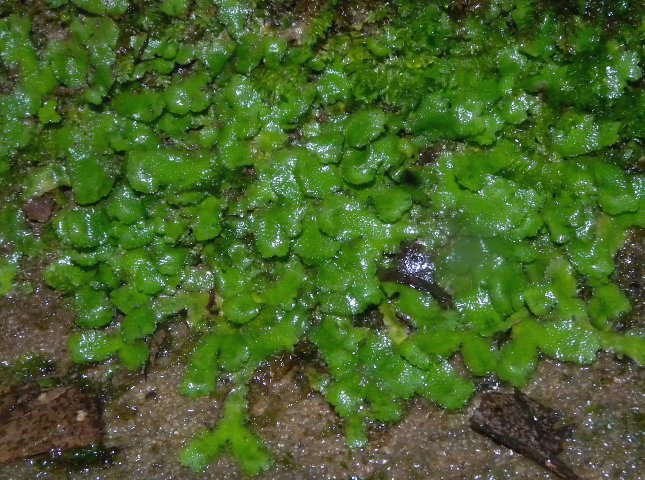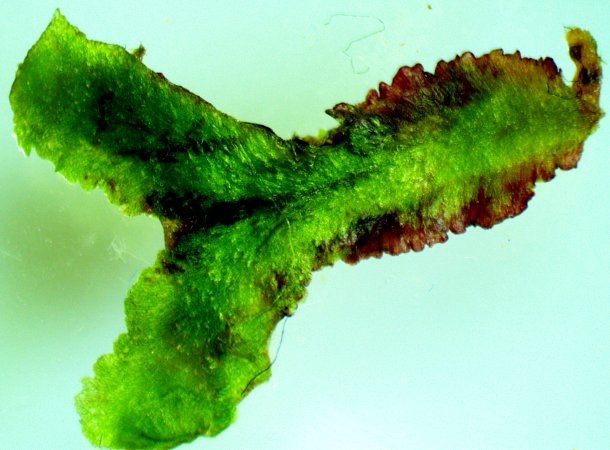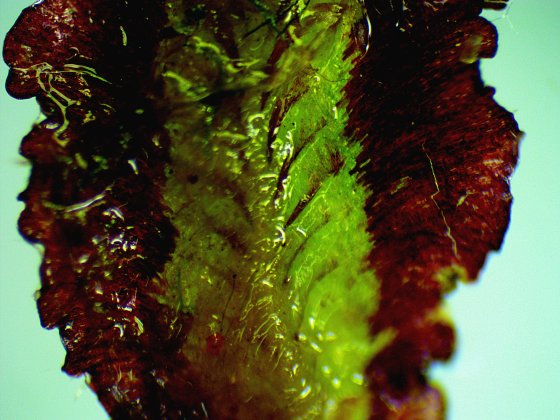
This liverwort is monoecious (at least in North America), as both male and female reproductive organs are present on the same plant (thallus). The female reproductive organs (archegonia) are contained in a shallow dome-shaped receptacle that develops within the notches of the growing tips on the upper surface of a thallus. When this happens, a thallus will stop growing, although it may form 2 branches. The female receptacle is green and speckled with white from an abundance of air pores along its upper surface. The male reproductive organs (antheridia) are located within one or more reniform (kidney-shaped) or lunate (crescent moon-shaped) receptacles that are usually purplish and shallowly elevated on the upper surface of a thallus. The male receptacles are usually located only 1-10 mm. behind the female receptacle on the same thallus body or branch. After fertilization occurs, the male receptacles become somewhat shriveled, while the female receptacle becomes elevated on a stalk (seta) about 1-3 cm. high. Depending on the local ecotype, environmental conditions, and its maturity, this stalk can be white, light green, yellow, light purple, or dark purple; it is mostly terete, except for a narrow slit along one side. The dome-shaped head of the female receptacle (carpocephalum) becomes more lobed as it matures; there are typically 4-7 rounded lobes that become partially separated from each other by downward-sloping indentations. Along the underside of the elevated female receptacle, there is a ring of 4-7 ovoid spore cases. A white-membranous covering of the spore cases splits apart as they develop; immature spore cases are light green or yellowish green, while mature spore cases become dark purple or black. At the base of the stalk (seta) of the female receptacle, there is a tuft of membranous-white filaments, while another tuft of membranous-white filaments occur at the apex of the stalk where the female receptacle is located. The spore cases split open to release their spores to the wind; because they are rather large in size for spores, they may not travel far. Individual spores are 65-80 micrometers across, globoid in shape, yellow to brown, and winged.

Cultivation: The preference is light to medium shade, moist humid conditions, and either thin soil over rock or bare rock (usually sandstone or limestone). This thalloid liverwort tolerates drying out occasionally.
Range & Habitat: The native Purple-fringed Liverwort is widely scattered throughout Illinois (see Distribution Map), where it is uncommon overall. This liverwort is widely distributed throughout the world, occurring on all continents except Antarctica. In Illinois, habitats include the rock walls of cave entrances, sandstone walls of rocky hollows, ledges and crevices along north-facing sandstone and limestone cliffs, moist shaded areas of sandstone outcrops in woodlands, sandy soil along woodland streams, shaded muddy banks of creeks, bases of sandstone bluffs, sandstone ravines and gullies in wooded areas, rocky wooded hillsides, ground soil of hill prairies, and sandy hills with tufts of grass. In Illinois, Purple-fringed Liverwort prefers high-quality natural areas where damp shaded sandstone and limestone rocks are present.
Faunal Associations: Very little is known about floral-faunal relationships for this liverwort in North America. Because the released spores of this liverwort often cling to the white filaments of the stalked female receptacles, and these filaments can cling to passing insects, birds, and mice, these animals may help to spread the spores to new locations. In the city of Philadelphia, USA, the common Garden Springtail (Bourletiella hortensis) was observed to spread the spores of Purple-fringed Liverwort (Reboulia hemisphaerica) by this method (Frank, 2015). In Japan, the larvae of snipe flies (Rhagionidae) mine through the thalli of liverworts belonging to the Aytoniaceae and Conocephalaceae (Imada & Kato, 2016).

Photographic Location: The face of a damp sandstone rock in a deep ravine at the Portland Arch Nature Preserve in west-central Indiana. Close-up photos were taken with a microscope.
Comments: This is a moderate-sized thalloid liverwort. It is similar in appearance to several other thalloid liverworts, but it can be distinguished from these species by considering the following features: 1) its thalli are typically 6-8 mm. across, 2) the margins of its thalli are often purplish, 3) its mature thalli have purple undersides with 2 rows of purplish scales, 4) whitish air pores are barely visible with the naked eye on the upper surface of its thalli, 5) indentations separating the cells of air pores are not visible to the naked eye on the upper surface of its thalli, and 6) the margins of its thalli curl upward when they dry out, rather than remaining flat. If the male and female receptacles are present, they are also useful in identification: 1) the small male receptacles are kidney-shaped or crescent-shaped, purplish, and sessile, 2) the males receptacles are usually located only 1-10 mm. behind each female receptacle on a thallus, 3) there are white filaments at the apex and base of the stalk of the elevated female receptacle, and 4) the female receptacle has 4-7 rounded lobes at maturity. The most similar liverwort species in Illinois is Preissia quadrata. This latter thalloid liverwort is about the same size as Purple-fringed Liverwort (Reboulia hemisphaerica), but its white air pores are more visible on the upper surface of the thallus and the margins of its thallus remain relatively flat when it dries out, instead of curling upward. Other similar liverworts have thalli that are smaller in size (4-6 mm. across) or larger in size (at least 8 mm. across or more).